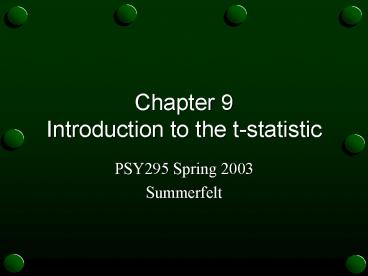Chapter 9 Introduction to the t-statistic - PowerPoint PPT Presentation
1 / 19
Title:
Chapter 9 Introduction to the t-statistic
Description:
Chapter 9 Introduction to the t-statistic PSY295 Spring 2003 Summerfelt Overview CLT or Central Limit Theorem z-score Standard error t-score Degrees of freedom ... – PowerPoint PPT presentation
Number of Views:99
Avg rating:3.0/5.0
Title: Chapter 9 Introduction to the t-statistic
1
Chapter 9Introduction to the t-statistic
- PSY295 Spring 2003
- Summerfelt
2
Overview
- CLT or Central Limit Theorem
- z-score
- Standard error
- t-score
- Degrees of freedom
3
Learning Objectives
- Know when to use the t statistic for hypothesis
testing - Understand the relationship between z and t
- Understand the concept of degrees of freedom and
the t distribution - Perform calculations necessary to compute t
statistic - Sample mean variance
- estimated standard error for X-bar
4
Central limit theorem
- Based on probability theory
- Two steps
- Take a given population and draw random samples
again and again - Plot the means from the results of Step 1 and it
will be a normal curve where the center of the
curve is the mean and the variation represents
the standard error - Even if the population distribution is skewed,
the distribution from Step 2 will be normal!
5
Z-score Review
- A sample mean (X-bar) approximates a population
mean (µ) - The standard error provides a measure of
- how well a sample mean approximates the
population mean - determines how much difference between X-bar and
µ is reasonable to expect just by chance - The z-score is a statistic used to quantify this
inference - obtained difference between data and
hypothesis/standard distance expected by chance
6
Whats the problem with z?
- Need to know the population mean and variance!!!
Not always available.
7
What is the t statistic?
- Cousin of the z statistic that does not require
the population mean (µ) or variance (s2)to be
known - Can be used to test hypotheses about a completely
unknown population (when the only information
about the population comes from the sample) - Required a sample and a reasonable hypothesis
about the population mean (µ) - Can be used with one sample or to compare two
samples
8
When to use the t statistic?
- For single samples/groups,
- Whether a treatment causes a change in the
population mean - Sample mean consistent with hypothesized
population mean - For two samples,
- Coming later!
9
Difference between X-bar and µ
- Whenever you draw a sample and observe
- there is a discrepancy or error between the
population mean and the sample mean - difference between sample mean and population
- Called Sampling Error or Standard error of the
mean - Goal for hypothesis testing is to evaluate the
significance of discrepancy between X-bar µ
10
Hypothesis Testing Two Alternatives
- Is the discrepancy simply due to chance?
- X-bar µ
- Sample mean approximates the population mean
- Is the discrepancy more than would be expected by
chance? - X-bar ? µ
- The sample mean is different the population mean
11
Standard error of the mean
- In Chapter 8, we calculated the standard error
precisely because we had the population
parameters. - For the t statistic,
- We use sample data to compute an Estimated
Standard Error of the Mean - Uses the exact same formula but substitutes the
sample variance for the unknown population
variance - Or you can use standard deviation
12
Estimated standard error of mean
Or
13
Common confusion to avoid
- Formula for sample variance and for estimated
standard error (is the denominator n or n-1?) - Sample variance and standard deviation are
descriptive statistics - Describes how scatted the scores are around the
mean - Divide by n-1 or df
- Estimated standard error is a inferential
statistic - measures how accurately the sample mean describes
the population mean - Divide by n
14
The t statistic
- The t statistic is used to test hypotheses about
an unknown population mean (µ) in situations
where the value of (s2) is unknown. - Tobtained difference/standard error
- Whats the difference between the t formula and
the z-score formula?
15
t and z
- Think of t as an estimated z score
- Estimation is due to the unknown population
variance (s2) - With large samples, the estimation is good and
the t statistic is very close to z - In smaller samples, the estimation is poorer
- Why?
- Degrees of freedom is used to describe how well t
represents z
16
Degrees of freedom
- df n 1
- Value of df will determine how well the
distribution of t approximates a normal one - With larger dfs, the distribution of the t
statistic will approximate the normal curve - With smaller dfs, the distribution of t will be
flatter and more spread out - t table uses critical values and incorporates df
17
Four step procedure for Hypothesis Testing
- Same procedure used with z scores
- State hypotheses and select a value for a
- Null hypothesis always state a specific value for
µ - Locate a critical region
- Find value for df and use the t distribution
table - Calculate the test statistic
- Make sure that you are using the correct table
- Make a decision
- Reject or fail to reject null hypothesis
18
Example
- GNC is selling a memory booster, should you use
it? - Construct a sample (n25) take it for 4 weeks
- Give sample a memory test where µ is known to be
56 - Sample produced a mean of 59 with SS of 2400
- Use a0.05
- What statistic will you use? Why?
19
Steps
- State Hypotheses and alpha level
- Locate critical region (need to know n, df, a)
- Obtain the data and compute test statistic
- Make decision































